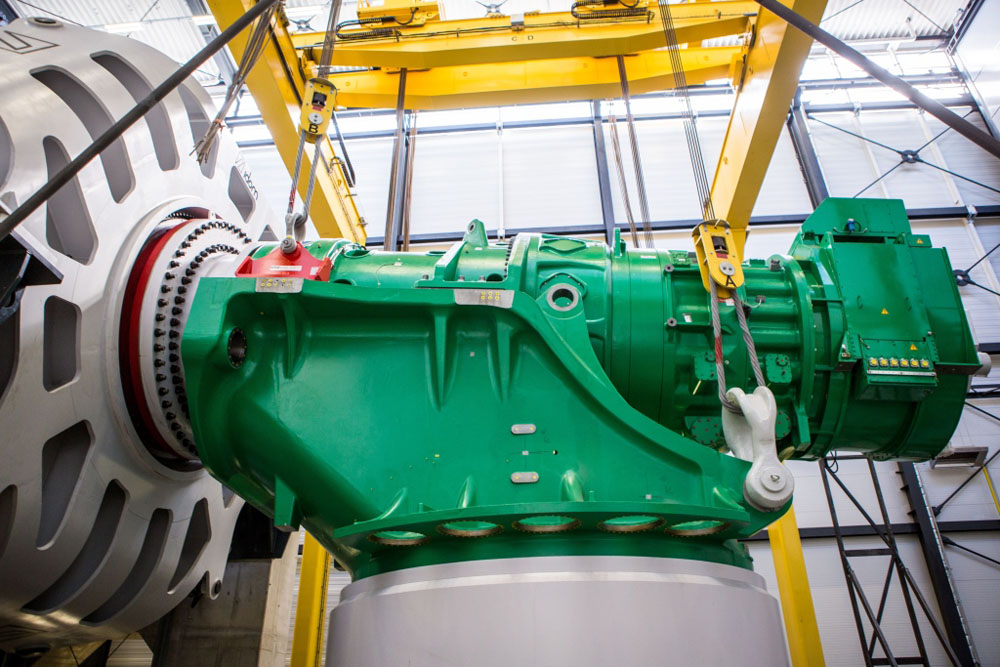
Realistic wind load reproduction
Wind torque is reproduced using two excited synchronous motors which are arranged in tandem and have a drive power of 5 MW each. This means that 10 MW are provided for the test operations. This in turn, means a nominal torque application of 8,600 kNm on the specimen. The complete test stand drive is tilted to an angle of 5°. This corresponds with the actual positioning of a wind energy turbine in the field and thus represents the realistic load situation. The engine torque is applied to the specimen via a link coupling.
The reproduction of mechanical wind loads such as driving torques or bending moments are created by hydraulic force application. The load-bearing structure is connected with a flange adaptor via a moment bearing. By this means, torque and forces can be transferred from the non-rotating load-frame onto the rotating shaft. Using this unique configuration bending moments of ca. 20,000 kNm and thrust in the range of 1,900 kN can be achieved. Furthermore, radial loads can also be reproduced dynamically. The force transmission furthers the nacelle test stand by five additional degrees of freedom. With the aid of a drive motor and the hydraulic force application the interactions between nacelle and rotor blades can be simulated realistically in the DyNaLab.
Here, wind load simulations can comprise of simulations from varying static and dynamic operating conditions as also from real-time simulation load data. In order to test wind energy turbines as comprehensively as possible, pitch systems as well as yaw systems can be integrated into turbine testing. For this purpose, individual system control values using actuators are implemented in realtime simulation.
Simulation of various network situations
Further focus lies in electrical network simulation and the resulting possibility of nacelle electrical nacelle certification on the test stand. In order to achieve this, the world’s most comprehensive grid simulation is installed in the DyNaLab. Here, static tests can be carried out in order, for example, to examine effective and idle power in various network situations or the thermal behaviour of electronic components. Furthermore, transient grid events can be simulated which can impact the complete nacelle system. For this purpose, dynamic Low-Voltage-Ride- Through (LVRT) and High-Voltage-Ride- Through (HVRT) events corresponding to the respective grid codes are simulated on the test stand. An inverter capacity equivalent to 40 MVA is available for these tests. Harmonic current behaviour and nacelle system perturbation can also be investigated in DyNaLab.
Hardware in the loop
Due to the missing rotor and tower, the nacelle has different system characteristics on the test stand than those in the field. In order to simulate real conditions in the laboratory occurring loads and the interactions between nacelle and rotor are calculated and applied. The necessary wind turbine real-time models and the appropriate control algorithms are developed and the necessary hardware components specified in order that the test stand including specimen can operate in the Hardware in the Loop (HiL).
Reduction of time-to-market
Through grid and HiL load simulations different load scenarios under reproducible conditions can be created and wind energy turbine behaviour tested in such scenarios as multi-dips in the grid during storms, network short-circuiting through incorrect pitch control or emergency stops. Besides certification in the field, DyNaLab offers the possibility of greatly reducing certification through application on the test stand, to date a time consuming process, since different operating scenarios can be started up as many times as required in the DyNaLab. In this way, both operational management and control can be optimized and model validation implemented. In addition, wind energy turbine reliability and availability can be increased and, at the same time, maintenance and repair costs reduced.
TECHNICAL DATA
- LVRT-Tests under reproducible conditions (different grid-codes)
- Control and operation optimiz
- Mechanical nacelle component investigations
- Model validation
- Efficiency measurements
- Investment volume: ca. 30 Mio. Euro
- Force application: dynamic application of 20 MNm bending moment, ca. 2 MN thrust forces
- Nominal torque: 8,6 MNm
- Overload torque: 13 MNm
- Drive Performance: 10 (15) MW
- Artificial network with 40 MVA installed inverter power
- Measurements: more than 600 synchronous, high resolution measuring channels
CONTACT
Turbine and System Technology, Fraunhofer IWES
This email address is being protected from spambots. You need JavaScript enabled to view it.
